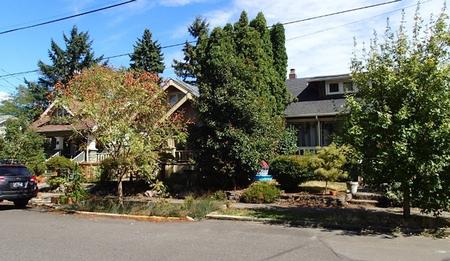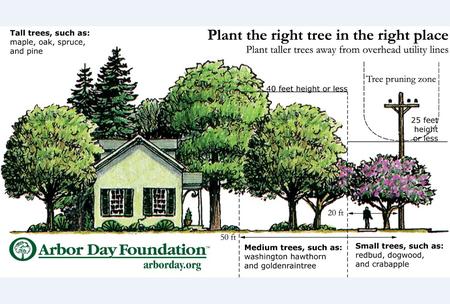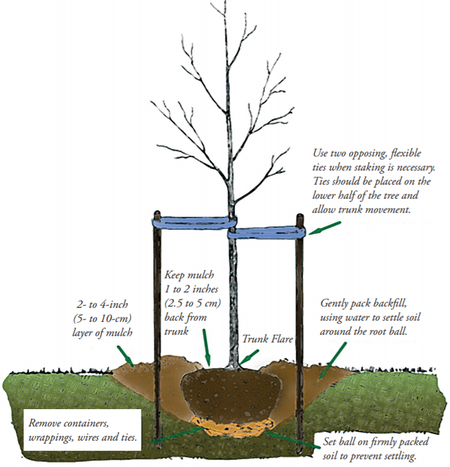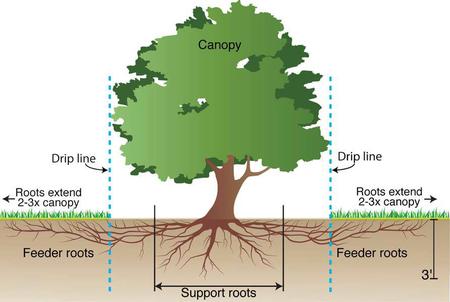Selecting, Planting, and Caring for Street Trees
Thinking of planting a street tree?
Do you have space for a tree in the parking strip, that no man’s land between the sidewalk and the street? If you do, there are many advantages to having trees grow in that space.
Why plant a tree?
- Trees are beautiful and welcoming. Trees have a calming and healing effect on people and the community. They add value to the neighborhood.
- Trees help us to live with warming temperatures. Street trees, part of the landscape, help to reduce the effect of urban heat islands by providing cooling shade to sidewalks, buildings, and other structures that capture heat.
- Trees fight climate change. Trees absorb and store carbon dioxide, also reducing greenhouse gas emissions to the atmosphere.
Trees add to the natural habitat. They can provide habitat for birds, pollinators, and other wildlife. - Trees improve the local environment. They provide windbreaks, capture stormwater runoff, and muffle urban noise, among many other things.
Janet Hartin, Environmental Horticulturist, UC Cooperative Extension, San Bernardino, Riverside, and Los Angeles Counties, states that “Unfortunately, their average lifespan in our cities is less than 1/4 of their potential due to poor selection and care." Trees for Tomorrow Start Today
Tips on Street Tree Selection
Gather information about the site (your parking strip)
- Check with the city. Find out whether homeowners are allowed to plant a tree. In some cities, only the city can plant in the parking strips.
- Power lines? Determine whether the power lines are on your side of the street or not. If they are, then you are limited to small trees that are "ok" to plant under the high voltage lines.
- Width of parking strip? Measure the width in inches of the parking strip where you are planning to plant your tree to compare your dimensions to those of the suitable tree basin width.
- Other considerations? Think about the type of soil you have, the availability of water, shade, proximity to buildings, and wind conditions.
Look around in your neighborhood to see what you like and don’t like in street trees.
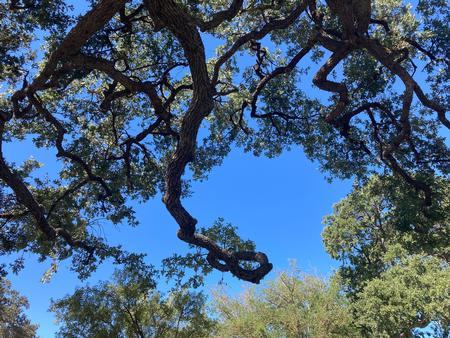
- Seeing a mature, full-grown specimen of a particular species of tree in your neighborhood is very different from seeing a photo of the tree on the Internet. Often the in-person view will give you a really good feel for a tree's true appearance and it may also show you other aspects such as the amount of litter from flowers, seeds, and leaves.
- Talk to your neighbors about the trees in your neighborhood.
- As you drive or walk around the city, look around at the street trees and take note of the ones that you like and where they are located.
- If your city has a public works department, parks department, or an urban forester, you may be able to get help with the identification of the trees and may also get recommendations.
What trees are approved for street trees in your area?
- Many cities, but not all, have an approved list of street trees. These are the trees that are officially approved for planting in the parking strip. The list often has additional information as to how to select trees for a particular site.
- Many cities have an urban forester who manages the selection and care of tree populations in the urban setting. Often the forester may be part of public works or parks division of city programs. Sometimes there are programs that promote tree planting and financial incentives might be available.
- Local tree lists and planting information for some of the cities of Alameda County. Please contact your city hall or public works for information in your city.
- Alameda County
- Albany
- City of Alameda
- Berkeley
- Dublin
- Emeryville
- Fremont
- Hayward
- Oakland
- San Leandro
- Trees for Oakland
(Please note that this organization works WITH the City of Oakland, but is not a part of the official City of Oakland's Tree Services.) - Unincorporated communities of Ashland, Castro Valley, Cherryland, Fairview, San Lorenzo, and Sunol
- http://www.acgov.org/cda/planning/trees.htm
- http://www.acgov.org/sustain/what/ecosystem/ufp.htm
- Union City
What are the characteristics of the trees on your list?
- Research both the common name and the botanical name, so you will get more information on the tree including information on litter issues, root damage potential, and mature size.
- Trees are either deciduous (lose their leaves in the fall) or evergreen (keep leaves/fronds/needles year-round). Just because a tree is an evergreen, does not mean that you don't have leaf litter. Evergreen trees may drop some leaves more or less year around instead of the once-a-year leaf drop in the fall.
- Once you have narrowed your list down to a few trees, you might give the city a call and find out if there is information on where you can see that type of tree locally.
- Minimize potential damage to the sidewalk. To avoid or minimize sidewalk/curb damage/lifting, choose a smaller tree that fits your parking strip and be sure to water the tree appropriately.
Care of trees … things I wish I had known
Unfortunately, street trees are sometimes not planted with the ideal tree selection/planting guidelines. Fortunately, many of these problems can be corrected if noticed early on, soon after the tree has been planted.
Here are some practical tree care tips from Janet Hartin, a UCCE horticulturist.
- Trees for Tomorrow Start Today
- How to Avoid Common Ailments of Landscape Plants
- Landscape Tree Irrigation 101
You may find that you will use this information on the care of trees directly if you end up planting your own tree, or you might find that you will use the information to make sure your tree is planted correctly by the city/contractor hired by the city.
4 Tips on Planting trees
- Plant the tree in native soil, with NO amendments or compost.
- Plant in the native soil without adding any amendments or compost. The hole for the tree should be the same depth as its container and at least 2-1/2 times wider. Make sure that the flare of the crown is above ground. Remove the soil, gently place the tree in the hole, fill with original soil around the plant
- Prevent circling and kinked tree roots. Straighten or cut off circling or kinked roots. Roots circle or become kinked when there is no space for roots to grow out, such as in containers or small plant holes, or organic-filled plant holes. When holes are filled with organic material, roots may never grow beyond the boundaries of the original hole because the roots prefer the richer organic material.
- Check/remove the tree ties or stakes. Remove any tree ties that are too tight and cut into the tree trunk or branches. Tree ties should be loose enough so that your tree can sway with the wind. This movement allows the trunk of the tree to develop more strength and flexibility over time. The ties and stakes may be removed as the lower trunk becomes stronger and self-supporting.
- Apply mulch 2-4 inches deep around your tree. Keep all plants and mulch several inches away from tree trunks.
8 Tips on Watering Trees
- Keep tree trunks dry. They should not come into contact with water from sprinklers or hoses.
- Apply the right amount of water at the right time.
- Water newly planted trees regularly for a full season. Many newly transplanted landscape trees die from the soil drying out too much between waterings. Regularly water newly planted trees. The tree root systems are small and need to be kept moist for a full growing season.
- Water the newly planted, drought-tolerant species too. This schedule of regularly watering newly planted trees holds true for drought-tolerant species as well as those that require more water. Once plants become well-rooted they should be watered less often but for longer periods of time.
- Water halfway to dripline and beyond. Since tree roots spread outward as well as downward, water should be applied beyond the dripline of the tree, if possible.
- Most established trees need water too. Most trees in California need supplemental irrigation above and beyond the naturally occurring rains, especially in times of drought. Water established trees less often but more deeply to encourage deep rooting and structural balance above and below ground.
- Trees need to be watered slowly and deeply. If you use a garden hose, apply the smallest trickle of the water slowly, moving the hose every few hours to water the entire area around the tree. The deep watering encourages roots to grow downward and help prevent sidewalk damage.
- Do NOT water trees on the same irrigation/drip system as the one used for lawns and groundcovers. The light, frequent watering every few days that is appropriate for lawns/groundcovers discourages the deep growth of tree roots.
Tip on Pruning Trees
Prune trees only as needed and avoid topping them. Hire a credentialed and knowledgeable arborist to correctly care for your trees. Find a list of International Society of Arboriculture Certified Arborists in your area.
Thinking about tree selection and predicted future climate change
You might select trees that are more suited for future warming trends. For instance, in 2099 the climate in Berkeley may be more like that of Santa Ana.
“Urban foresters in inland cities of California should begin reconsidering their palettes of common street trees to prepare for warmer conditions expected in 2099 due to climate change,” said the study's co-author, Igor Lacan, UC Cooperative Extension environmental horticulture advisor in the Bay Area.
Street trees are important in so many ways:
Trees provide beauty and calm, help us to live with warmer temperatures, fight climate change, provide a natural habitat for wildlife including birds and pollinators. It is important to properly select, plant, and care for street trees so that the benefits of each street tree can be realized to its full potential.
Resources
More resources on the importance of trees, tree selection, tree care:
Three articles with more details on tree selection and tree care from Janet Hartin, UCCE horticulturist.
- Trees for Tomorrow Start Today
- How to Avoid Common Ailments of Landscape Plants
- Landscape Tree Irrigation 101
If you want more details of how to plant a tree with photos, here is a good source: “Save the Planet, (Learn How to) Plant a Tree” by Dr. Linda Chalker-Scott who is an ISA certified arborist and an ASCA consulting arborist. She is also WSU’s Extension Urban Horticulturist and a Professor in the Department of Horticulture.
- GreenBlog -- Green news from the UC Division of Agriculture and Natural Resources
- The importance of trees to cool urban heat island
- Lush urban forests can help communities face climate change
- Trees also can have a calming and healing effect on people and the community
- Cities in California inland areas must make street tree changes to adapt to future climate -Cooperative Extension San Joaquin County
Really good source of information on arboriculture and getting the most benefit from trees through good management. - UC study seeks street trees that can cope with climate change
Want to learn more?
This blog post is brought to you by the Help Desk of the UC Master Gardeners of Alameda County. Subscribe to our blog!
Have a gardening question? We'll help. You can reach us by:
- Emailing acmg@ucanr.edu. Please include a photo of the problem, if you can, plus your name, phone number, city and a description of the problem.
- Using our online form.
- By phone, during our office hours, 10 am to noon Wednesday and 11 am to 1 pm Thursday: 510-670-5645. At other times, please leave a message and we'll return your call during our office hours.
- In person at our Hayward office, during our office hours, only by appointment.


